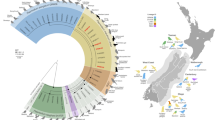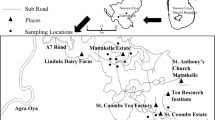Abstract
The cardiovascular nematode Angiostrongylus vasorum is spreading in the fox and dog populations of northern Europe. A. vasorum can result in severe clinical manifestations in dogs; therefore, specific diagnosis is crucial for assessing its prevalence. In the present study, faecal samples from foxes and domestic dogs were tested by a new polymerase chain reaction (PCR) targeting the second internal transcribed region of the ribosomal DNA (ITS2) of A. vasorum. Initial isolation of faecal larvae by sieving facilitated the processing of larger sample volumes and allowed for the recovery of dead larvae from frozen samples. The sieve-PCR method enabled the identification of a single larva per 2 g of faecal sample and did not amplify DNA of a range of canine helminths, thus presenting a non-invasive tool for wildlife surveillance and for confirmative diagnosis in dogs.
Similar content being viewed by others
References
Al-Sabi MNS, Kapel CMO, Deplazes P, Mathis A (2007) Comparative copro-diagnosis of Echinococcus multilocularis in experimentally infected foxes. Parasitol Res 101:731–736
Barcante JMP, Barcante TA, Dias SRC, Vieira LQ, Lima WS, Negrao-Correa D (2003) A method to obtain axenic Angiostrongylus vasorum first-stage larvae from dog feces. Parasitol Res 89:89–93
Bolt G, Monrad J, Frandsen F, Henriksen P, Dietz HH (1993) The common frog (Rana-temporaria) as a potential paratenic and intermediate host for Angiostrongylus vasorum. Parasitol Res 79:428–430
Caldeira RL, Carvalho OS, Mendonca CLFG, Graeff-Teixeira C, Silva MCF, Ben R, Maurer R, Lima WS, Lenzi HL (2003) Molecular differentiation of Angiostrongylus costaricensis, A. cantonensis, and A. vasorum by polymerase chain reaction-restriction fragment length polymorphism. Mem Inst Oswaldo Cruz 98:1039–1043
Conboy G (2004) Natural infections of Crenosoma vulpis and Angiostrongylus vasorum in dogs in Atlantic Canada and their treatment with milbemycin oxime. Vet Rec 155:16–18
Cury MC, Lima WS, Guimaraes MP, Muzzi RAL, Bregunci GC (2001) Radiology, eletrocardiography and echocardiography for the diagnosis of Angiostrongylus vasorum (Baillet, 1866) infection in dogs. Rev Med Vet 152:153–156
Davidson RK, Oines O, Madslien K, Mathis A (2009) Echinococcus multilocularis adaptation of a worm egg isolation procedure coupled with a multiplex PCR assay to carry out large-scale screening of red foxes (Vulpes vulpes) in Norway. Parasitol Res 104:509–514
Denk D, Matiasek K, Just FT, Hermanns W, Baiker K, Herbach N, Steinberg T, Fischer A (2009) Disseminated angiostrongylosis with fatal cerebral hemorrhages in two dogs in Germany: a clinical case study. Vet Parasitol 160:100–108
van Doorn DCK, van de Sandea AH, Nijssea ER, Eyskera M, Ploegera HW (2009) Autochthonous Angiostrongylus vasorum infection in dogs in The Netherlands. Vet Parasitol 162:163–166
Helm J, Gilleard JS, Jackson M, Redman E, Bell E (2009) A case of canine Angiostrongylus vasorum in Scotland confirmed by PCR and sequence analysis. J Small Anim Pract 50:255–259
Helm JR, Morgan ER, Jackson MW, Wotton P, Bell R (2010) Canine angiostrongylosis: an emerging disease in Europe. J Vet Emerg Crit Care 20:98–109
Hendrix CM, Robinson E (2006) Diagnostic parasitology for veterinary technicians. Elsevier Science, Amsterdam
Jefferies R, Morgan ER, Shaw SE (2009) A SYBR green real-time PCR assay for the detection of the nematode Angiostrongylus vasorum in definitive and intermediate hosts. Vet Parasitol 116:112–118
Koch J, Willesen JL (2009) Canine pulmonary angiostrongylosis: an update. Vet J 179:348–359
Madsen AB, Dietz HH, Henriksen P, Clausen B (1999) Survey of Danish free living otters Lutra lutra—a consecutive collection and necroscopy of dead bodies. IUCN Otter Spec Group Bull 16:65–76
Mathis A, Deplazes P, Eckert J (1996) An improved test system for PCR-based specific detection of Echinococcus multilocularis eggs. J Helminthol 70:219–222
Morgan ER, Shaw SE, Brennan SF, De Waal TD, Jones BR, Mulcahy G (2005) Angiostrongylus vasorum: a real heartbreaker. Trends Parasitol 21:49–51
Oliveira SD, Barcante JMP, Barcante TA, Dias SRC, Lima WS (2006) Larval output of infected and re-infected dogs with Angiostrongylus vasorum (Baillet, 1866) Kamensky, 1905. Vet Parasitol 141:101–106
Patterson-Kane JC, Gibbons LM, Jefferies R, Morgan ER, Redrobe SR (2009) Pneumonia due to Angiostrongylus vasorum infection in a red panda (Ailurus fulgens fulgens). J Vet Diagn Invest 21:270–273
Roepstorff A, Nansen P (1998) The epidemiology, diagnosis and control of helminth parasites of swine. Food and Agriculture Organization of the United Nations, Rome
Saeed I, Maddox-Hyttel C, Monrad J, Kapel CMO (2006) Helminths of red foxes (Vulpes vulpes) in Denmark. Vet Parasitol 139:168–179
Traversa D, Guglielmini C (2008) Feline aelurostrongylosis and canine angiostrongylosis: a challenging diagnosis for two emerging verminous pneumonia infections. Vet Parasitol 157:163–174
Verzberger-Epshtein I, Markham RJF, Sheppard JA, Stryhn H, Whitney H, Conboy GA (2008) Serologic detection of Angiostrongylus vasorum infection in dogs. Vet Parasitol 151:53–60
Willesen JL, Jensen AT, Kristensen AT, Kjelgaard-Hansen M, Jessen R, Koch J (2004) Tidlig diagnostik af Angiostrongylus vasorum (fransk hjerteorm) og Crenosoma vulpis (rævens lungeorm) hos hunde er mulig ved hjælp af modificeret Baermann test. Dan Vet Tidsskrift 87:6–10
Acknowledgements
We would like to acknowledge Prof. Jørgen Koch for providing materials and Charlotte Fischer for her help in the lab.
Author information
Authors and Affiliations
Corresponding author
Rights and permissions
About this article
Cite this article
Al-Sabi, M.N.S., Deplazes, P., Webster, P. et al. PCR detection of Angiostrongylus vasorum in faecal samples of dogs and foxes. Parasitol Res 107, 135–140 (2010). https://doi.org/10.1007/s00436-010-1847-5
Received:
Accepted:
Published:
Issue Date:
DOI: https://doi.org/10.1007/s00436-010-1847-5




